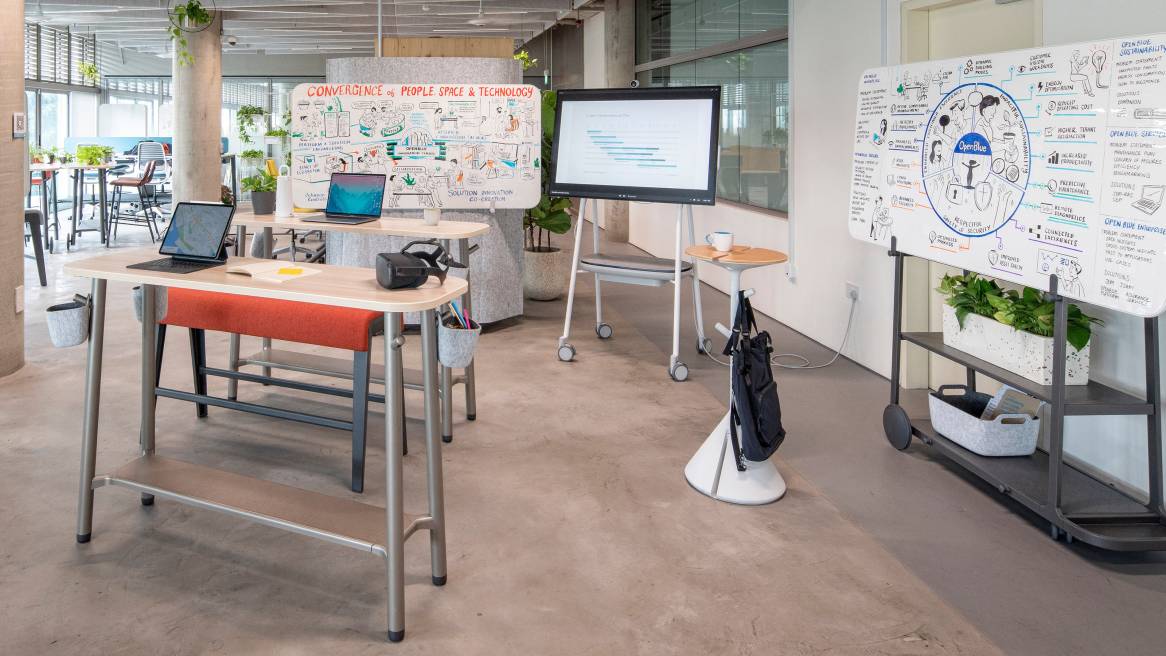The Future of Work Starts Now
Johnson Controls and Steelcase bring their shared vision to life in Singapore’s OpenBlue Innovation Center
Johnson Controls, a building technology and solutions leader, recently opened the S$50 million OpenBlue Innovation Center, based in the National University of Singapore (NUS)’s School of Design and Environment.
The product of a partnership between NUS, the Singapore Government, Johnson Controls and ecosystem partners including Microsoft and Steelcase, the center is both an everyday workplace and a living laboratory to showcase the next generation of solutions built on Johnson Controls OpenBlue unifying technology suite to enable the future of work.
So what exactly does this future look like? As 2020 has shown us only too well, the way we work will be flexible, mobile and able to adapt to rapid changes in the environment. Recent research by Steelcase studying high performing teams has highlighted that in order for innovation to flourish, work must be hyper-collaborative, agile and iterative. To effectively manage fluid projects, teams must be able to cycle between being actively connected and breaking apart for focused time.
As Julie Barnhart-Hoffman, Principal Design Researcher for Steelcase, said in a recent article on the new approach to work, “We need to design for multidisciplinary teamwork in a way that also gives the individual what they need to do their best work.”
BREAKING NEW GROUND IN CONNECTED BUILDINGS
The OpenBlue Innovation Center is part of a pioneering effort by Johnson Controls to link core building technology with behavioural, wellness and spatial data to develop Internet of Things (IoT) solutions that meet new demands for safety and sustainability in connected workplaces. It’s an area ripe for fresh thinking, as unlike the smart home industry, a common ‘language’ for building technology has yet to be developed.
“If you think about the built environment, you have technology, people and space, and new and efficient value is created where those three elements intersect.”
The center is housed in SDE4, Singapore’s first new-build netzero energy building. Sensors fitted throughout the indoor space, including on furniture, measure temperature, humidity, volatile organic particles, noise levels, airflow and occupancy.
Engineers from the center and collaborating NUS researchers will collect and analyse data using OpenBlue to gain an understanding of the interactions between technology, indoor environments and occupant wellbeing, and how these can be optimised.
“We want to create a blueprint for a human-centric, connected and dynamic space of the future”
Alvin NgVice President, Digital Solutions, Asia Pacific, Johnson Controls
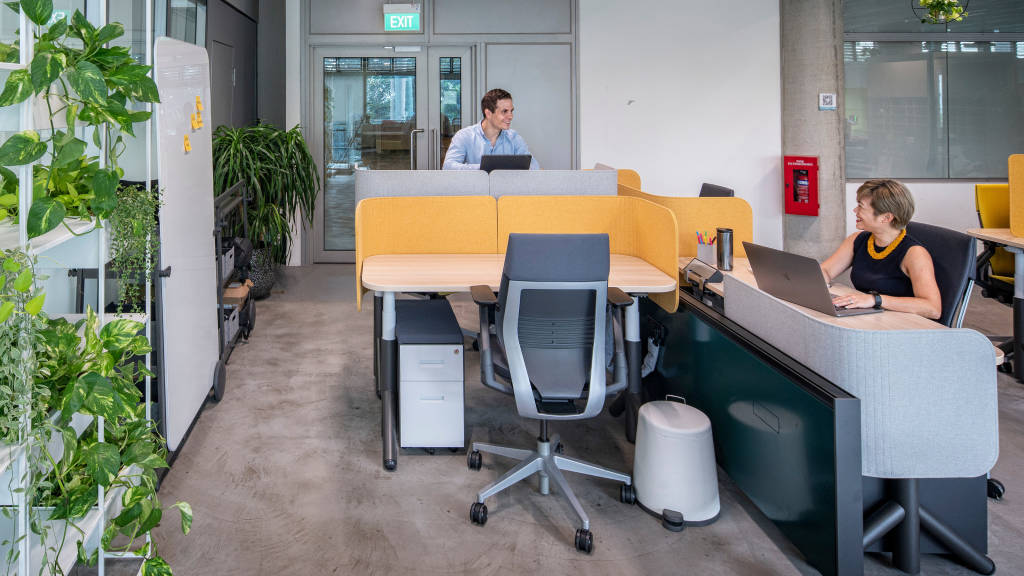
Small team neighborhood spaces with height-adjustable desks accommodate both individual and team needs.
DESIGN FOR DIVERSE TEAMS
The OpenBlue Innovation Center plays host to a fluctuating population. It includes Johnson Controls employees from the ecosystem and platform and application engineering teams, who are joined for co-creation and co-innovation by partners and start-ups from the Johnson Controls ecosystem, as well as NUS students completing research using behavioural and wellness data.
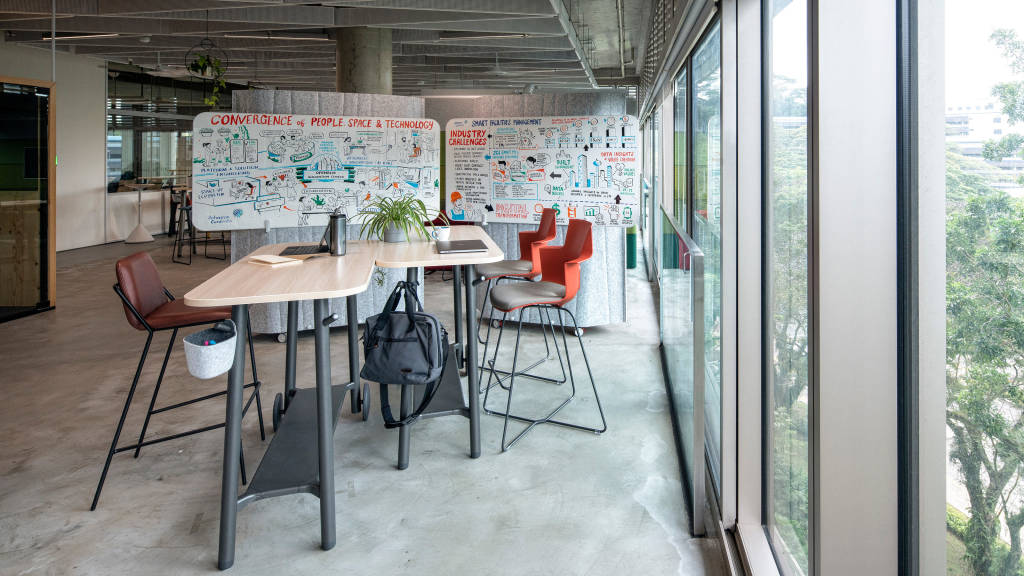
Furniture from the Flex Collection facilitates the creation of dynamic collaborative spaces for teams, by teams.
Steelcase was tasked with creating a flexible, agile and dynamic space that could cater to the constantly shifting needs of this workforce.
“Steelcase brings the perspective on how space and design can play a bigger role in terms of behaviour – how people are collaborating, how people can increase their productivity – and wellness,” says Ng. “Space impacts technology, which impacts people.”
Though the project kick-off pre-dated the COVID-19 pandemic, its influence also inevitably flowed through to the design of the center. When the space opened in September 2020, and some employees returned to shared workplaces for the first time, additional flexibility in how the environment could be used was needed to accommodate new post-COVID protocols such as social distancing and contact tracing.
MAKING AGILE EASY
As a software developer, Johnson Controls utilises scrum or agile project management methodology, which is characterised by small teams undertaking project ‘sprints’, punctuated by regular check-ins and iterative processes, with groups coming together and breaking off for different tasks. This fast-moving, fluid approach to work is becoming increasingly common not only in the technology space, but also among teams undertaking any kind of knowledge work with innovation and collaboration at its heart.
Steelcase undertook focus groups to identify Johnson Control’s needs and pain points, and observed worker behaviour so they could design a furniture solution that could facilitate this dynamic, nimble style of work.
The Steelcase Flex Collection was chosen for its ability to create totally configurable team ‘neighbourhoods’ from a selection of fixed height and height adjustable tables, huddle hubs, analogue markerboards, moveable acoustic barriers, mobile carts and the industry’s first enterprise level mobile power. Winner of a 2019 NeoCon award, the Steelcase Flex Collection empowers teams and individuals to take control of their space, and personalise the configuration to adapt to their changing needs. Microsoft Surface Hub devices paired with Steelcase Roam stands added mobile digital devices to the toolkit.
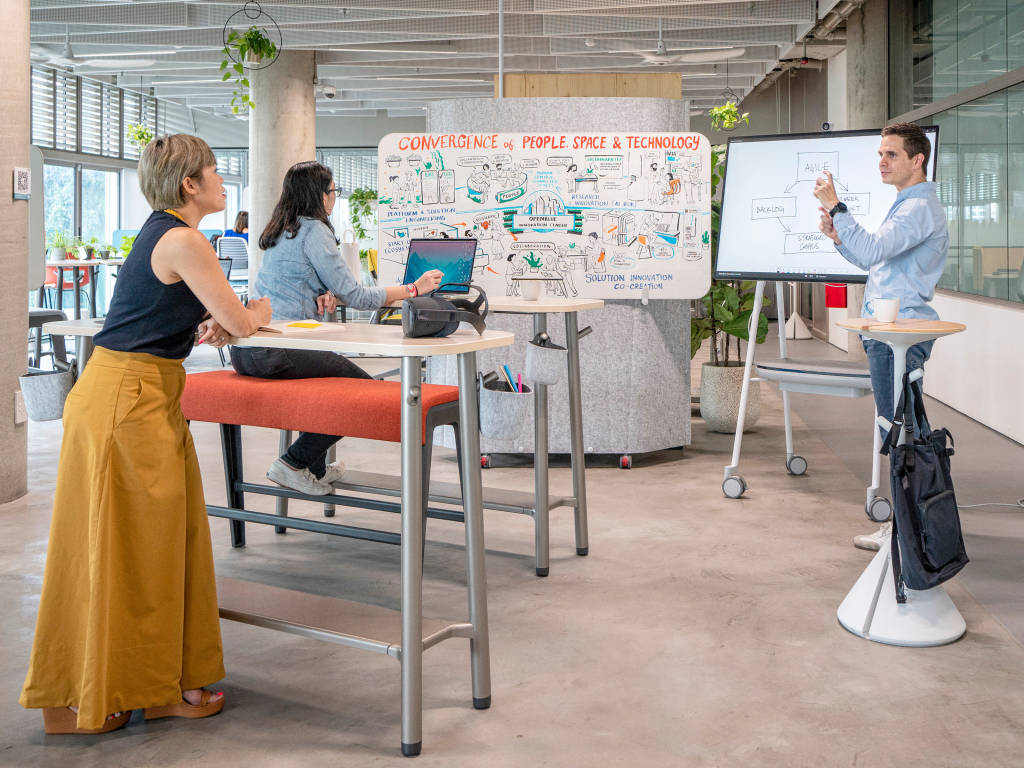
Johnson Controls data science lead, APAC IT, Chloe Li, works in the centre with students and partners, and has found the furniture and space simple to customise.
“This means that whenever we have different groups coming in, they always find themselves comfortable. We have always been able to create the right kind of environment to observe social distancing regulations, because of the mobility,” Li says. “The design is really open, and it relaxes people. The right physical environment can infuse a creative state of mind. I really like the different possibilities that this space can create.”
Given that collaboration doesn’t always happen around a desk, another critical element of the design was providing high-performance ancillary spaces. Orangebox ergonomic furniture has been used to create comfortable yet highly functional collaborative areas, with Air3 acoustic pods providing more private focus space. This modular, reconfigurable pod can act as a freestanding internal meeting room, phone booth or touchdown room, with a high level of insulation and speech privacy, and can be moved around a building.
“With organisations facing a volatile environment, a hallmark of the future workspace strategy is flexibility, and this combination of products delivers that,” says Samantha Giam, Steelcase Product Marketing Director.
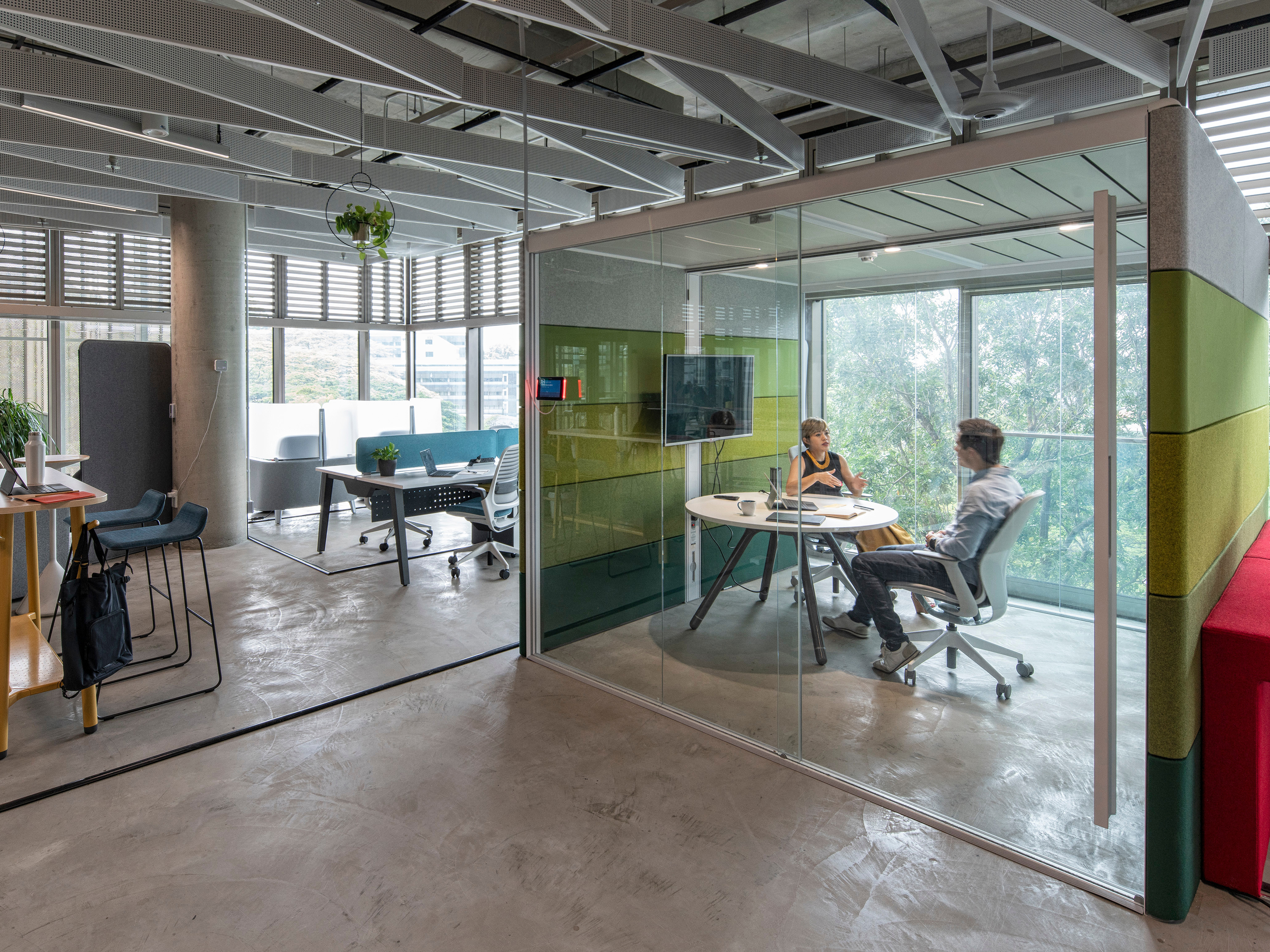
An Orangebox pod creates a private space for meetings and focus time.
SMART CONNECTIONS
The OpenBlue Innovation Center is a showcase of how Johnson Control’s platform and solution suite can bring together multiple building systems into a common data interface from which actionable insights can be drawn.
“It’s got to be future-proof, moveable on
Samantha GiamSteelcase Product Marketing Director
demand, and able to adjust to uncertainty, because you never know what’s next.”
One such system is the smart, contactless RoomWizard system provided by Steelcase Smart + Connected, which allows users to book meeting rooms based on the size and amenities required for their meeting direct from the Companion App. Connected with the network of sensors in the building, RoomWizard enables autobook and autorelease capability – that is, if someone enters the room, the sensors automatically detect their presence and book the room, and a booking is released when a user vacates the room or does not show up for a booking.
Markus Heinrich, APAC Director for Steelcase Smart + Connected, says this tool helps to reduce friction for employees as they return to the office, by ensuring people have access to the type of rooms and the tools they need.
Patterns in the booking data combined with utilisation information gained from sensor data can also be used to identify how efficiently spaces are being used and how they can be optimised.
“That type of information is just golden, because sometimes it’s so simple – you could just add a whiteboard or screen to a room,” Heinrich says. “You can increase wellbeing if the space is responding to the needs of people better, and if people are happier, the outcome is also better.”
It’s just one example of the feedback loop that can be created from data that is collected from the connected environment.
“Our platform is constantly creating a very adaptive environment for people to collaborate and co-exist, and the ability to keep creating that lifecycle is very important,” Ng says. “But if you don’t have the right design, the right furniture, the right IoT devices within that space, you can’t drive this dynamically.”
SAFE, SECURE AND SUSTAINABLE
As people return to work, organisations must go behind ensuring compliance with health regulations to create a sense of physical and psychological safety in order to get the best from their workers.
The smart features of the Innovation Center are helping to deliver this for its occupants – through completely contactless check-in via face recognition, sensor-based monitoring of density and spacing of people in meeting rooms, and measuring air quality and carbon dioxide levels. Johnson Controls has focused on improving the biophilia by adding more indoor plants and using these plants between seating for social distancing.
“Even as our occupancy rate is increasing, our carbon dioxide levels are coming down. The air is a lot fresher, there’s more oxygen, you don’t get sleepy, and therefore productivity increases,” Ng says.
The connected environment also offers clear sustainability advantages in a building that already has solid credentials in terms of its construction. Linking room booking systems with building management systems can reduce wastage of cooling, heating, lighting and other devices such as screens, by turning these amenities off when rooms are not in use, or adjusting for low occupancy. Smart lights can respond to the level of light outside the building, and IoT fans work in tandem with traditional air-conditioning to maintain a comfortable internal temperature while still saving energy.
Additionally, Ng argues there’s nothing more engaging and empowering for building occupants than putting data and control in the palm of their hands.
“If I can give the employee an app that becomes his smart meeting room arranger, he understands space utilisation, he knows how to navigate within a building, he gets sustainability scores and carbon footprint in his dashboard, and he can see how social distancing is maintained, it creates a new experience – it is safe, it is secure and it drives sustainability engagement,” he says.
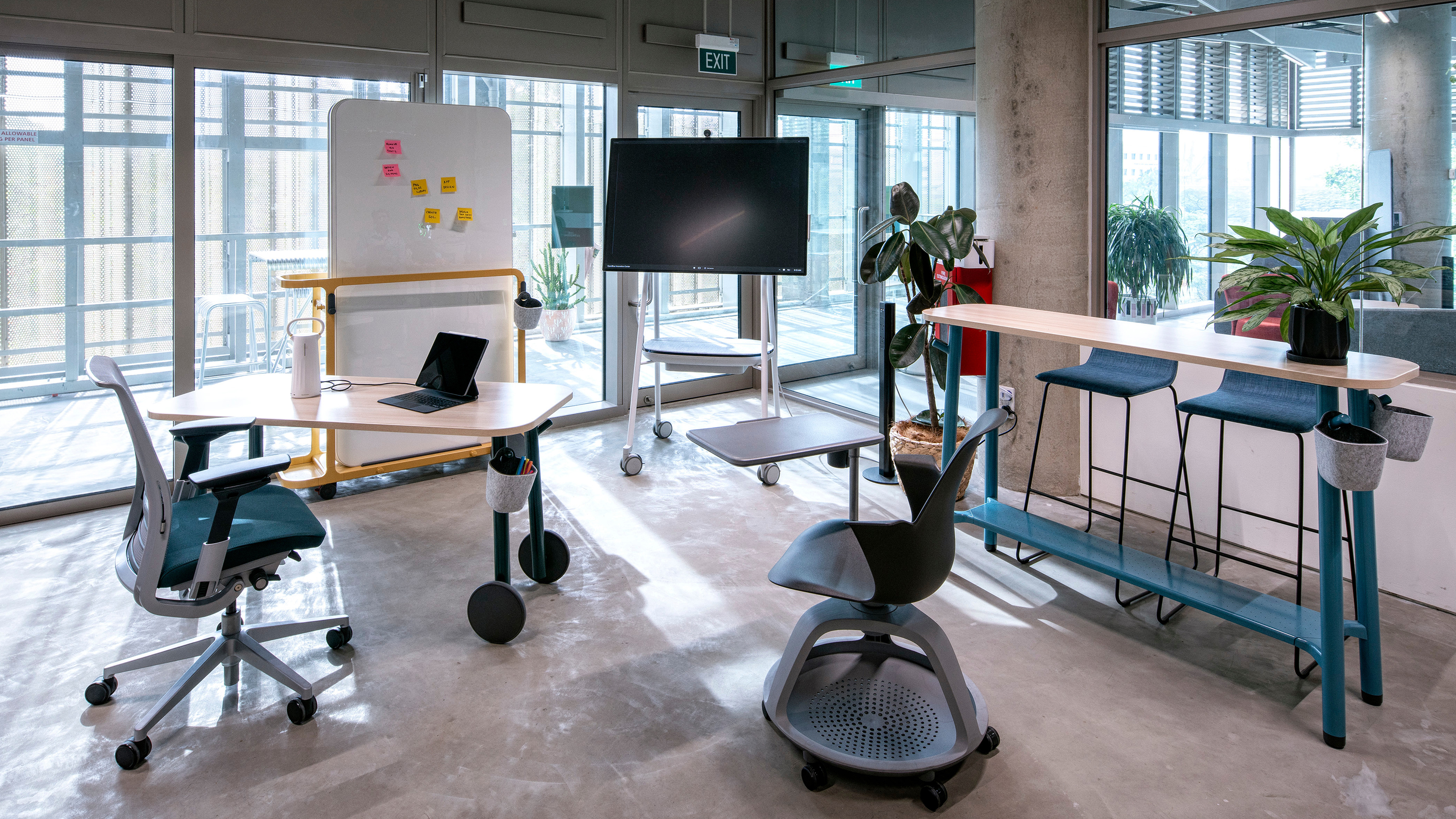
The Flex system moves wherever users need it to be, for whatever task.
LOOKING AHEAD TOGETHER
Heinrich says the Steelcase and Johnson Controls partnership provides a unique opportunity to co-create.
“Working with Johnson Controls is really a learning opportunity for us because we get great feedback. We look forward to a point in the future when we can easily integrate our various systems and then customise the ecosystems for what our clients are really looking for, so we’re very happy to be part of that journey.”
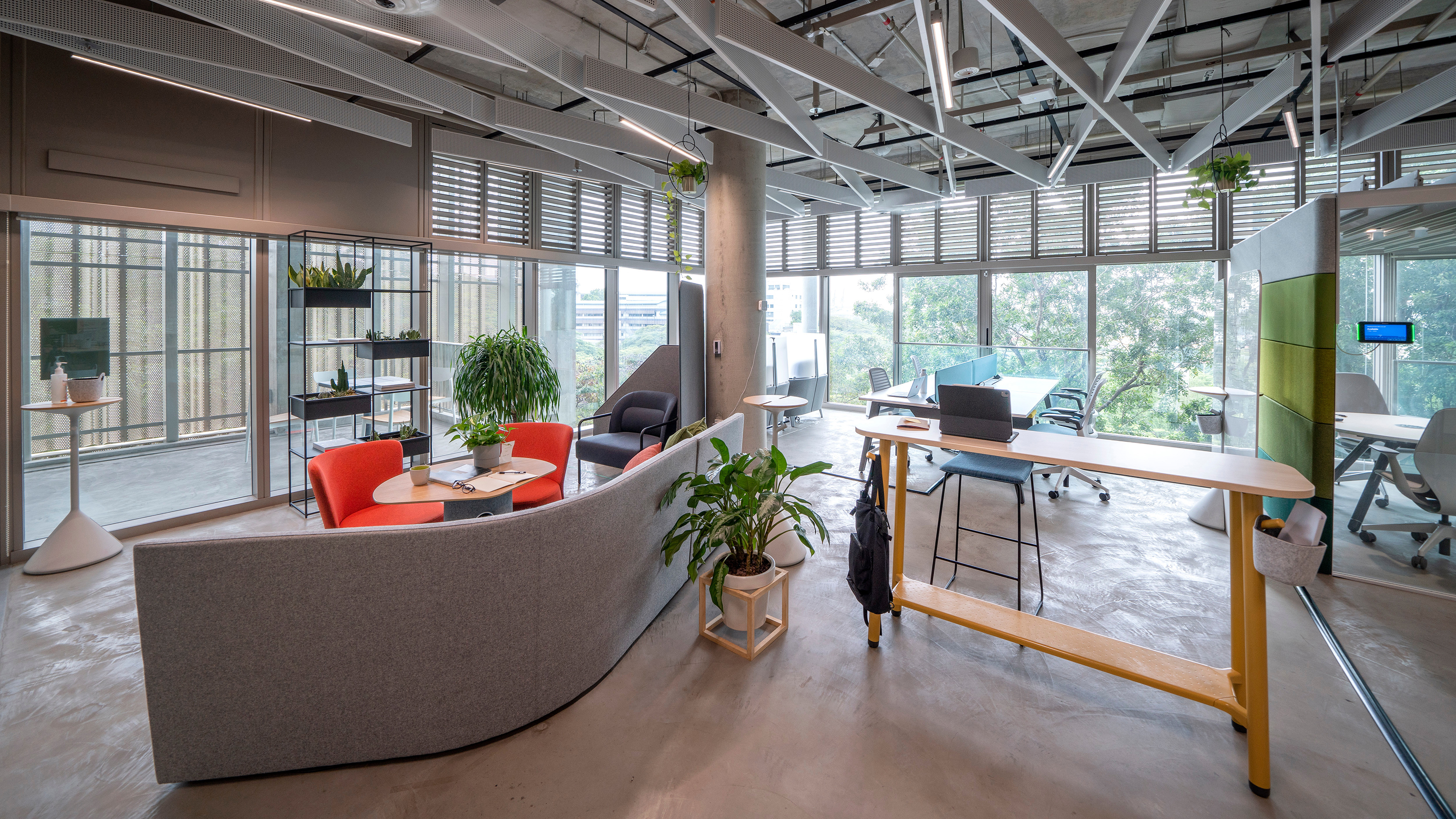
Biophilic elements enrich the space and user experience.
And while the OpenBlue Innovation Center provides the chance for teams to tussle with these technological challenges, it will also provide inspiration for organisations to imagine a more frictionless collaborative future, Ng says.
“One of the most common pieces of feedback by people who visit the center is, ‘Wow, I didn’t know a workspace could be that agile and flexible’. We begin to see the world that is driven by data, we begin to see the world that is extremely dynamic, and I have to hand it to Steelcase for really partnering with us to make this happen.”

